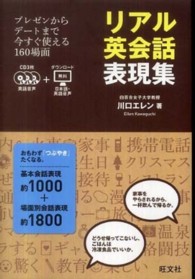- ホーム
- > 洋書
- > ドイツ書
- > Mathematics, Sciences & Technology
- > Chemistry
Full Description
A must-have guide to welding aluminium alloys for optimized performance and precision
Aluminium alloys, widely used across industries due to their high specific strength and corrosion resistance, require precise joining methods to maintain their structural integrity. Welding Metallurgy of Aluminium Alloys: Design, Processes, and Simulations provides a detailed exploration of aluminium alloy welding, addressing the science, technology, and applications behind this essential process. Integrating essential theory and real-world practice, this comprehensive volume equips readers with the knowledge to analyze, optimize, and execute welding processes while preventing common defects that compromise weld quality.
Presenting insights rooted in over 450 research articles, an experienced team of researchers and practitioners examines microstructural evolution, thermal dynamics, defect mechanisms, and more. Detailed chapters cover various welding methods, including arc, beam, resistance, and solid-state welding, while providing clear guidance on topics ranging from mitigating hot cracking and porosity to simulating temperature distributions and residual stress.
Providing the knowledge to tackle an array of welding challenges, Welding Metallurgy of Aluminium Alloys:
Features in-depth case studies and simulation methodologies that enable practical application and innovation in diverse industries
Explores mechanisms behind welding defects and presents strategies for prevention and mitigation
Discusses simulations for temperature distribution, thermal history, residual stress, and material flow during welding processes
Highlights microstructural changes and metallurgical transformations unique to each welding process covered
Includes extensive reference material, such as equations for heat conductivity analysis and defect prediction tailored to aluminium welding
An indispensable resource for designing robust, high-performance welds, Welding Metallurgy of Aluminium Alloys: Design, Processes, and Simulations is ideal for undergraduate and graduate courses in materials science, mechanical engineering, and welding technology, as well as a must-have reference for welding specialists, materials scientists, and construction engineers. It is also a vital addition to any technical library supporting professional development and academic programs focused on advanced joining processes.
Contents
Preface vii
List of Abbreviations ix
1 Aluminum Alloys: Fundamentals of Welding Metallurgy 1
1.1 Introduction 1
1.1.1 Aluminum-Copper Alloys 4
1.1.2 Aluminum-Zinc-Magnesium Alloys 4
1.1.3 Aluminum-Magnesium-Silicium 4
1.1.4 Aluminum-Lithium Alloys 5
1.2 Weldability 5
1.2.1 Aluminum Oxide 6
1.2.2 Hydrogen and Pore Formation 7
1.2.2.1 Effects of Porosity on the Mechanical Behavior 10
1.2.3 Hot Cracking 10
1.3 Thermal Cycle and Its Effect on the Weld Zone 23
1.4 Welding of Aluminum to Other Metals 30
References 31
2 Arc Welding Processes 37
2.1 Introduction 37
2.2 Processes 38
2.2.1 TIG Welding 38
2.2.2 Plasma Arc Welding 39
2.2.3 MIG Welding 40
2.3 Modifications to the Processes 42
2.3.1 Negative-Pole and Positive-Pole TIG Welding 42
2.3.2 Keyhole TIG (K-TIG) Welding 42
2.3.3 Activated-Flux TIG (A-TIG) Welding 44
2.3.4 Double-Wire MIG Welding 44
2.3.5 Indirect Electric Arc 46
2.3.6 Cold Metal Transfer (CMT) Welding 47
2.3.7 Positive-Pole Plasma Welding 47
2.3.8 Hyperbaric Welding 48
2.4 Hybrid Welding 48
2.4.1 Plasma-MIG Welding 49
2.4.2 TIG-MIG Welding 51
2.5 Protective Gases 52
2.6 Filler Material 53
2.7 Grain Refinement in the Weld 53
2.8 Grain Structure 59
2.9 Defects During Arc Welding 60
2.9.1 Segregation 60
2.9.2 Smut 61
2.9.3 Pores 62
2.9.4 Hot Cracking 62
2.10 Welding of Dissimilar Metals 64
2.11 Simulation of the Arc Welding Processes 67
References 72
3 Beam Welding Processes 83
3.1 Introduction 83
3.2 Laser Systems 87
3.3 Defects Formation During Laser Welding of Al Alloys 88
3.3.1 Mechanism of Pore Formation 88
3.3.2 Hot Cracking in Laser Welding 93
3.4 Shielding Gases in Laser Welding 96
3.5 Modifications to Laser Welding of Al 98
3.5.1 Multi-spot Laser Beam Welding 98
3.5.2 Micro-laser Welding 99
3.5.3 Pulsed Laser Beam Welding 99
3.5.4 Hybrid Laser Welding 103
3.5.5 Oscillation Laser Beam Welding 104
3.5.6 Vibration-Assisted Laser Beam Welding 105
3.5.7 Hot-Wire Laser Welding 106
3.6 Special Cases of Al Welding 107
3.6.1 Additive Manufacturing 107
3.6.2 Cast Aluminum 107
3.6.3 Welding of Aluminum to Dissimilar Materials 108
3.7 Simulation of Laser Welding 109
References 115
4 Resistance Welding Process 125
4.1 Introduction 125
4.2 Weld Zones 131
4.2.1 Nugget Zone 131
4.2.2 Thermo-Mechanically Affected Zone (TMAZ) 133
4.3 Defects During RSW of Al Alloys 135
4.4 RSW of Dissimilar Aluminum Alloys 137
4.5 RSW of Al to Dissimilar Metals 139
4.6 Modifications to RSW for Welding Al Alloys 144
4.7 Simulation of the Process 149
4.8 Evaluation of the Joints 152
References 155
5 Solid-State Welding Process 163
5.1 Introduction 163
5.2 FSW of Al Alloys 164
5.3 FSW of Al-Matrix Composites 172
5.4 FSW of Al to Dissimilar Materials 175
5.5 Joint Design 180
5.6 Simulation of the Process 184
References 186
Index 193








